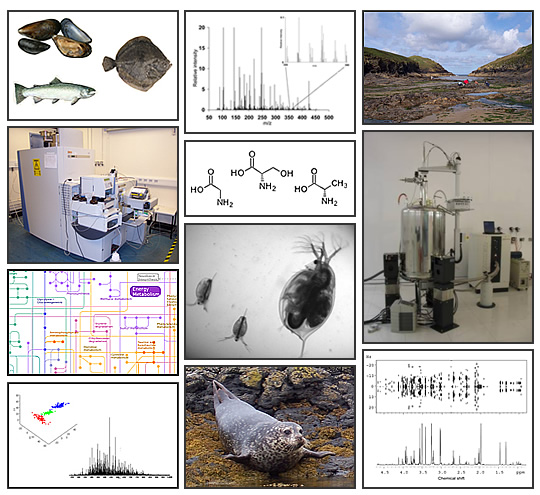Environmental Metabolomics Research Laboratory
Professor Mark Viant's research group in the School of Biosciences specialises in developing and applying metabolomic techniques to investigate
mechanisms of sub-lethal stress,
primarily in aquatic organisms. This includes the development of NMR spectroscopy and high resolution FT-ICR mass spectrometry, as well as associated bioinformatic approaches.
We investigate the effects of environmental pollutants,
including nanoparticles, in
algae, aquatic invertebrates and fish. Mark Viant has ISI researcherID
B-6339-2009
with citations at

The images above summarise some of the group's research areas. We are interested in the application of metabolomics to toxicity testing and environmental monitoring, including the characterisation of the metabolic modes of action of environmental stressors. We study multiple species, from the tiny - water fleas (Daphnia magna) - to mid sized - particularly marine mussels and various fish species - to the large - grey seals. In addition we develop and subsequently apply high-throughput NMR methods, with a particular focus on 2-dimensional J-resolved spectroscopy. We also develop and utilise ultra-high resolution mass spectrometry techniques for metabolomic studies. Multivariate pattern recognition methods are used to classify the metabolic phenotypes of organisms to provide insight into their fitness and health, which can ultimately reflects upon the condition of the environment. A brief introduction to environmental metabolomics and it's application to the study of disease and toxicity in wildlife can be found here.

The images above summarise some of the group's research areas. We are interested in the application of metabolomics to toxicity testing and environmental monitoring, including the characterisation of the metabolic modes of action of environmental stressors. We study multiple species, from the tiny - water fleas (Daphnia magna) - to mid sized - particularly marine mussels and various fish species - to the large - grey seals. In addition we develop and subsequently apply high-throughput NMR methods, with a particular focus on 2-dimensional J-resolved spectroscopy. We also develop and utilise ultra-high resolution mass spectrometry techniques for metabolomic studies. Multivariate pattern recognition methods are used to classify the metabolic phenotypes of organisms to provide insight into their fitness and health, which can ultimately reflects upon the condition of the environment. A brief introduction to environmental metabolomics and it's application to the study of disease and toxicity in wildlife can be found here.